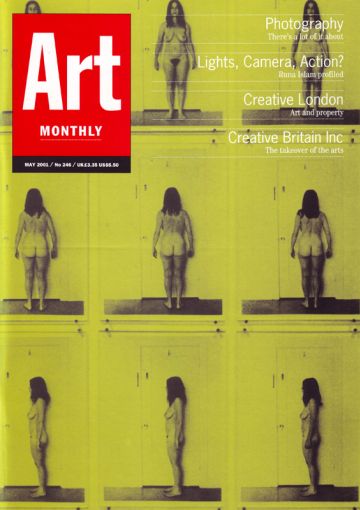Feature
Wanted: Studio Space
Andrew Wilson asks if artists need to become property developers to keep their studios
A history of the topography of artistic life in London over the last 500 years reveals a not unexpected dynamic – artists appear as nomads, moving around London districts in search of money, respectability, work or just fresh air. This movement reflects not only historical changes in both the social status of the artist from craftsman to bohemian to media celebrity, and artists’ professional relationships with patrons or dealers at the same time, but also changes in the character of those areas artists choose to settle in. In the 19th century artists could make an area fashionable just by their presence, as in the cases of Chelsea and Hampstead – artistic regeneration is not such a new concept after all.
‘Creative Quarters’ at the Museum of London intelligently charts this progressive colonisation of Covent Garden, Hampstead, Marylebone, Camden Town, Bloomsbury, Fitzrovia, Soho and, at the end of the 20th century, Shoreditch. Amidst a framework that explains where artists studied, lived, worked, bought their materials, exhibited and entertained, the exhibition and accompanying catalogue1 sets out a social history that asks why artists moved to these areas, what effect this had on their work and what impact the artists made on the areas in which they lived.
The implication of this exhibition and its final rooms, is that this process is not set to stop with the styling of Shoreditch and Hoxton as the cultural address and destination of choice. ‘Creative Quarters’, ending as it does with a history of artists in the East End over the last 40 years, reveals that recently a shift has taken place. What artists need from an area and what is available has changed, in the same way that the reasons why artists moved to the East End in the first place had itself formed a rupture with the past. Hampstead had provided the fresh air for John Constable and his tubercular wife in the 1820s. A little over a century later it provided the same healthy heaven for Ben Nicholson and Barbara Hepworth as well as modernist refuge from Nazi oppression for Bauhaus architects and artists as the 1930s rolled on towards war. In the 40s and 50s, Soho and Fitzrovia became a playground for social misfits whose goings-on in the surrounding pubs, bars and clubs were later chronicled by photographer Dan Farson, who characterised the area as a ‘sexual gymnasium’ for those whose way of life and work was at variance with prevailing social mores.
There was never anything healthy, respectable or safe about the East End, nor did it offer the same lurid and picaresque enticements that Soho had done. What it did have, however, was the space to live and work. The postwar decline in the industrial base of the area, accelerated by the economic depression at the end of the 60s and the containerisation of the docks, had left not only huge industrial buildings empty but also streets of boarded-up housing – the population having relocated in search of employment elsewhere. In the late 60s and 70s it was into this environment that both Space and Acme moved. Both organisations were founded by artists as a platform and a means of persuading local government and businesses into working with them to provide studio and living spaces. The remit of Space, however, extended beyond the provision of working space, as its name suggests (Space Provision, Artistic, Cultural and Educational). From the beginning at St Katharine’s Dock, a central aspect of its activity was the Art Information Registry (Air) which sought to put market power back into the hands of the artists and away from the dealers. Later Acme would take a similar role by its formation of the Acme gallery in the late 70s, but in 1972 its focus was firmly on the provision of both living and work spaces from the GLC’s stock of ‘short life housing’ and spread quickly out from its first successes in Devon’s Road E3 and later in Beck Road E8.
The use of ‘short life housing’, though useful in plugging a gap meant that, as in previous centuries, artists had to keep on the move. The other alternative, less secure and stable than the Acme or Space model, was the formulation of squats such as those in Hackney’s Ellingfort Road (celebrated at the Museum of London by Tom Hunter & James Mckinnon’s London Fields: The Ghetto, 1994) or Oval Mansions in Vauxhall. Where Acme and Space sought to work with local government, squats put artists onto a collision course with local councils who had different priorities for the regeneration or long-term viability of its housing stock. The main issue, put into high relief by the success of the marketing of Shoreditch in London (SoHo, for some London estate agents, now means South of Hoxton rather than New York’s South of Houston), is that the benefits for the artists are as short-lived as the building stock available to them. In the early 90s Shoreditch, close as it is to the centre of London, was one of the cheapest places for living and working. Originally, space was cheap, but in the last couple of years this has become, per square metre, some of the most expensive habitable commercial and domestic space in Europe and provides another classic example of artist-aided gentrification. The end result is that artists are priced out and move somewhere else, property developers and estate agents being the real winners as people get suckered into buying into a creative quarter where there is no longer much creation going on. Quite what artists get out of this equation is hard to see, other than being told to move on.
A similar story is provided by the example of Cubitt Studios. Initially set up in Kings Cross Goodsway in 1990, the artists then moved to a building in Cubitt Street in 1992, the building had to be relinquished to developers after three years. The artists then moved on to another building in Caledonia Street nearer Kings Cross. They have now moved yet again, and for the same reason, this time to Islington. In time, they will no doubt have to move on again. Not only is this lack of security disruptive, but more to the point, the artists and funding organisations are essentially putting money straight into the profits of developers without getting anything back apart from a place to work for a few years. A little under two years ago, Space convened the ‘UK Studio Providers Conference’ to examine the state of studio provision throughout Britain. At the conference, Jonathan Harvey, one of the directors of Acme, stated that ‘the ebb and flow of the property market is the single largest factor affecting the work of studio organisations. History reveals an enormous wastage of energy as buildings are acquired, inhabited, become energised and then subsequently lost. Artists have been both the unwitting pioneers and victims of speculative development.’ What might have been achieved if a coherent strategy had been evolved to use Lottery money to secure freeholds for studio space at a time when there was a depressed property market in the 90s? Now, however, there is little Lottery money left in the kitty and less expectation that it will be used for such ends (despite the government’s supposed awareness of what artists do; see Kate Tregaskis’s Analysis p52).
Even in 1976, four years after its initial formation, Acme saw the future in terms of long-term strategic planning and acquisition of freehold studio space: ‘Permanent property must be found and acquired as short-life property will not always be available. There are several ways in which groups of artists with individually low incomes could jointly purchase and convert their own property. There is a case for all groups working in the area of provision of studio space and accommodation to cooperate and to pool resources and information, rather than continue the fragmentary development being done at the moment.’2 This was a far-sighted view, given what happened to the domestic property market in the 80s during which time cheap property that might have once been available to Acme disappeared as the market grew stronger. Harvey reiterated this view in the 1999 Space conference in which he stated clearly that Acme’s focus had to be on ‘permanent acquisition’, so that artists ‘are able to control their own destiny’. Such a reliance on the ‘permanent solution’ to studio provision meant that Acme has had to start playing the property game, which positively entailed that fluctuations in the property market could be used to their advantage, but only if access could be gained to large amounts of capital funding. Although ACE might acknowledge the need to support individual artists and studios, on the whole it has been unwilling in the past to be fully proactive in its provision of adequate capital investment for studios.
Nevertheless, in 1997 Acme became the envy of other studio organisations when it secured £1.2m of Lottery funding which enabled it to purchase and develop two of its studio buildings in Copperfield Road (also housing Matt’s Gallery) and the Fire Station on Gillender Street in Poplar. Where Copperfield Road provides non-residential studio space, the Fire Station, once it had been restored and converted, accommodates a number of three-year work/live residencies supported by London Arts. Although this building provides a model for subsidised work/live spaces, it can come nowhere near meeting demand, especially with the numbers of studio buildings that have been lost recently, or that are under threat, the largest being Acme’s Carpenter’s Road building which will be vacated by June to be demolished – to make way for the Stratford International Rail Terminal – with the loss of 160 studios.
Last year, Acme moved closer to property development when it bought the freehold of the old Players Cigarettes factory in Hackney’s Orsman Road. Although Acme had maintained 30 studios in the building since 1983, the purchase of the freehold not only secures those studios but also almost doubles the studio space available. To fund the purchase, and to keep studio rents as low as it can, Acme is developing eight work/live spaces which will be for sale. In this way it is manoeuvring between maintaining relationships with local government and getting further in bed with the commercial sector so that its business can evolve slowly away from the ‘management of inherently vulnerable leasehold stock to a permanent and sustainable network of studios for artists in London’. Meanwhile, the artists occupying the Cable Street Studios have been struggling to buy their building and organisations like Space have had to remain locked into leasehold situations.
Acme sees its future in terms of property ownership, and other studio organisations may wish they could too, but the history of the last 500 years shows how artists have moved around London – a state that has perhaps enriched their art. The stability and safety provided by freehold studios can be a boon and blessing to artists, allowing them to concentrate on and consolidate their working practice, but as Richard Wentworth pointed out at the 1999 conference, ‘cities are changing, organic places. The nature of them means they don’t get stagnant.’ David Panton of Acme may be right when he states that artists ‘have moved to the East End and are staying put’, but what of those who are starting out on the trail and will be leaving art school this year? Where will they all go? Coherent strategies alongside greater investment from funding bodies are needed – permanency is just one solution.
1. Kit Wedd with Lucy Peltz and Cathy Ross, Creative Quarters: the art world in London 1700-2000, Museum of London, 2001. See also Michael Archer, ‘Oranges and Lemons and Oranges and Bananas’, Acme Rsearch Project Bulletin: Artsts in East London (1960-2000).
2. David Panton and Jonathan Harvey, Acme first publication, 1976.
Creative Quarters: The Art World in London 1700-2000 was at the Museum of London until 15 July 2001.
Andrew Wilson is deputy editor of Art Monthly.
First published in Art Monthly 246: May 2001.









